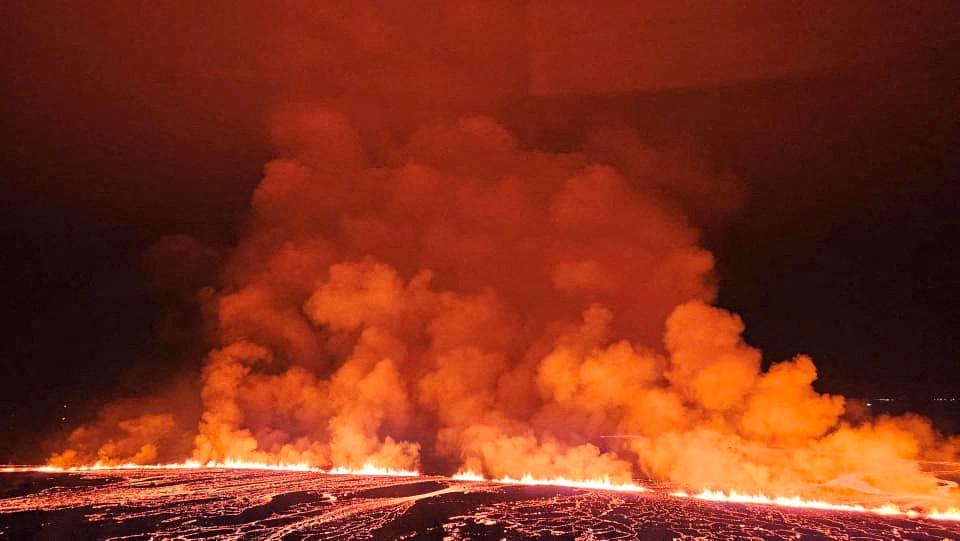More volcanic eruptions are expected in Iceland. And now the earth’s crust is so ravaged that the time between warning and eruption is getting shorter and shorter, says a geologist to Aftenposten.
New volcanic eruption in Iceland The video from AP shows where the flames rise from the cracks on the Reykjanes peninsula.martin
Published: 16.03.2024 21:39 | Updated: 17/03/2024 16:05
The short version
- The volcanic eruption in Iceland affected the area between Hagafell and Stóra Skógfell. The lava flowed 1.2 km south towards Grindavik in an hour and a half.
The summary is created with the help of artificial intelligence (AI) and quality assured by Aftenposten’s journalists.
Short version is for subscribers only
The volcanic eruption started between Hagafell and Stóra Skógfell on Saturday evening. This is near Grindavik. It happened after short-term seismic activity. Images in Icelandic media showed glowing lava spurting from the ground.
The hard-pressed residents of Grindavik were once again evacuated. The same happened to 700 people who were in the tourist attraction The Blue Lagoon.
This is the seventh eruption since 2021.
It is also the most powerful of the last four eruptions, according to geophysicist Magnús Tumi Guðmundsson.
He has flown over the 3.5 kilometer crack.
In an hour and a half, the lava flow had moved around 1.2 kilometers south towards Grindavik. The hope is that protective embankments built around the small town will protect it.
This is the fourth eruption since December 2023. Photo: Icelandic Coast Guard, AFP/NTB
The “Norwegian” geologist was at work
Ruv writes on Sunday morning that the lava flow to the south is much slower than on Saturday. But that the westward flow is still quite strong.
– The force of the eruption and the lava flow has decreased, confirms geologist Bjarki Kaldalóns Friis to Aftenposten at 8 o’clock on Sunday morning.
He works at the Reykjavik Meteorological Institute.
Geologist Bjarki Kaldalóns Friis monitored the eruption from Saturday evening and through the night. Photo: Private
From his office in the capital, he has a red-orange view of the ongoing eruption 30 kilometers away. He was the incoming night watchman when they received the first notifications at 7.30pm. Their measuring instruments showed increased activity and land uplift. A quarter of an hour later they were safe. A further half an hour later, at 20.23, the eruption started.
– Usually there are two of us at work, but then everything we have of people was activated, says Friis.
He grew up in Bærum, but in recent years has lived and worked in Iceland.
For a while, the experts suspected that the lava flows would reach all the way down to the sea. It is unlikely, according to Friis. The flow ends around a kilometer from the coast. Most likely, the outbreak will stop during the day, reports the broadcaster Ruv Sunday morning.
Shorter notices
This is the fourth eruption since December, and the magma has wreaked havoc with the Earth’s crust. As a result, outbreaks occur more quickly from the moment activity is first noticed.
– The underground is so molested and broken into pieces that it does not offer much resistance. The notices are getting shorter and shorter, says Friis.
He expects more outbreaks in the future.
– It is quite likely that this will continue, he says.
It is bad news for the roughly 4,000 inhabitants of Grindavik. They have been evacuated several times, most recently at the beginning of February.
Spectators observe the eruption on Saturday evening.
1 av 3Photo: Marco di Marco / AP / NTB
Then 20,000 households also lost their district heating when the lava destroyed roads and hot water pipes. During an eruption in January, a house in Grindavik burned to the ground due to hot lava.
In mid-February, the authorities decided that people could move home again, but only at their own risk.
On Saturday evening, the few residents who chose to move back were evacuated once again. The evacuation itself should have been carried out in around half an hour.
May be an outbreak in the city
– There are only residents in 10-20 houses there at the moment. The entire earth’s crust has been torn apart, and the city is full of fissures. The magma tunnel also runs under the city itself, says Friis.
In January a man fell into a large crack in Grindavik after one of the outbreaks.
– It is not very likely, but we also cannot rule out an outbreak in the city itself, says Friis to Aftenposten.
Keflavik Airport, which is the furthest north of Reykjanes, is not affected by the outbreak. Air traffic is still running as normal.
